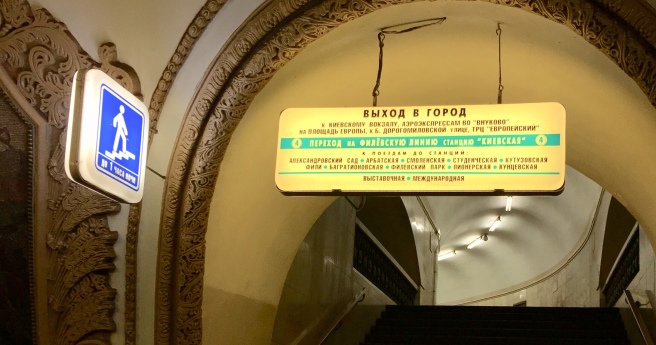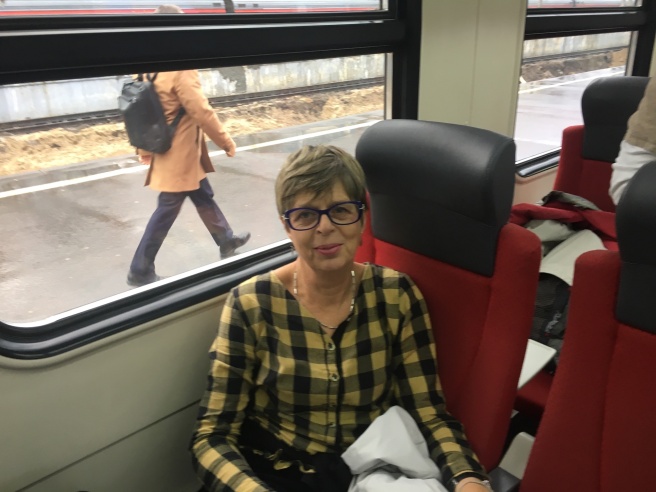
I was a little bit perplexed to find ‘Moscow Metro Tour’ as an inclusion on my Traveltalk ‘Highlights of Russia’ trip. I kind of shrugged my shoulders, thought ‘oh well’, and didn’t think anything more about it until the tour guide announced we would be going on the Moscow Metro that afternoon.
I thought at least this excursion should help me to get a handle on how to use the Metro. Previously I’ve used the New York subway, the Paris Metro, as well as the one on Barcelona. Obviously I use the London Underground a lot too. The hardest part for me has always been the initial establishing and following the ticketing system, and this is always harder when its a different language and even more when its a different alphabet – hence I didn’t attempt to use use public transport in Beijing when I was there earlier this year.
So that is how I came to find myself being handed two tickets and sticking to my tour guide like glue as my biggest fear at this stage was being left behind – either on a station platform or a train. I was really worried as we had yet to check into our hotel so I wouldn’t know where to head and this would be compounded by the unfamiliarity of the station names and the strange alphabet, all of which would mean I would be very, very, hopelessly lost.
It was as we gathered in the ticket hall at our first Metro station that I began to realise that there might be something different about the Moscow metro – we were in a massive marble/granite foyer with a memorial to the 1917 Revolution, and not only was it expansive, it was also very clean – no litter, no grime. The same was the case for the escalator, it was light, wide and spacious, and had art-deco era lights that lit the way. Once we got to the bottom we were greeted by a great cavernous space decorated with large bronze statues celebrating, what was at the time this particular station was opened (1954), Soviet socialist life and all that it brought to the Russian people.
This station was Ploschat Revolutsii, it was underneath Revolution Square and as it was opened at the heart of the Stalin era, its design and decoration definitely reflected this.
The Moscow Metro was opened in 1935 and at that time it consisted of 1 line and 13 stations. Fast forward to 2017 and there are 229 stations and 14 lines, and it’s used on average by just under seven million people each day. At the time it was opened it was celebrated as a technological and ideological victory for communism and by association for Stalin. This is somewhat ironic as while the Soviets did the labour and the art work, the main engineering designs and plans were handled by engineers who had previously worked on the London Underground.
The different stations have particular themes – thus you have the station dominated by chandeliers, and that feels like you are in a palace rather than a metro station.
Another station was decorated to celebrate the ties between Russia and the Ukraine -this too was a station built in the 50s when the Soviet world was very different, as the relationship between the two countries is a little different now. The stations make use of different art forms from plastering to mosaics to stain glass windows.
So how easy is it to use the Moscow Metro? Well considering the language difficulties it was surprisingly easy. The Metro map is very similar to the London one with its lines being colour coded and numbered. On most of the trains I used the next station was announced in English and in Russian, and so as long as you knew the name of your station you were likely to get off at the right place. The trains also had maps of the lines with both English and Russian on display, and as an added bonus the next stop was lit up on this map (one line we went on didn’t have this). The stations had helpful directions on the floor which helped to ensure you were travelling in the right direction. Unlike the London Underground the Moscow Metro has Wifi and the trains run like clockwork – I experienced no delays. Tickets cost 55 rubles per ride, and you can load more than one ride on your ticket, and go as far, and change lines as many times as you like for your ride.
On the last day I needed to get to the airport and it would have cost me 55€, which was a bit steep for me so I set myself the challenge of getting there by public transport. The first hiccup I struck was finding out that I had run out of journeys on my ticket, necessitating the loading of another journey onto it. Language was a bit difficult at the ticket office, but with some sign language I got what I wanted across, and as I only had 40 rubles left I was lucky that I was able to pay by card. From here it was one change, to the circle line at Kurskaya, and then to Paveletskaya, where I would catch the airport express train. The only real difficulty was finding the station for the airport train that was, as it turned out, diagonally across the Square from the Metro – but I suspect I missed a sign, because while I was waiting for the train I noticed what I think was a sign pointing directly to the Underground.

Writing this, it makes my journey to the airport sound oh so easy, but it required a lot of concentration, and dealing with feelings of fear and tension, but I’m glad I did it. As I go forward on my travels I intend to challenge myself like this more often. How about you, how have you found using public transport in strange places? I’d love it if you left me a comment below about your experiences.

































































